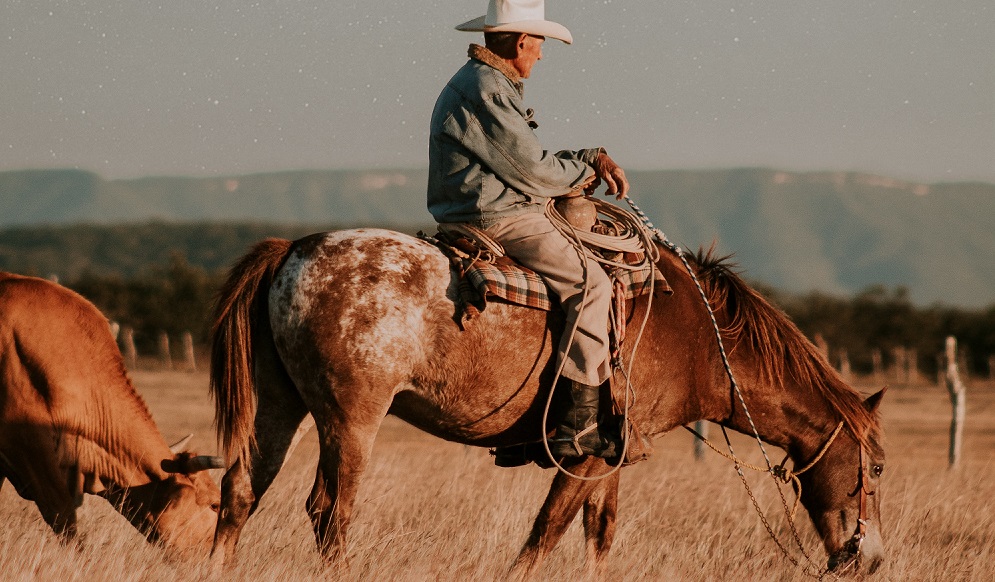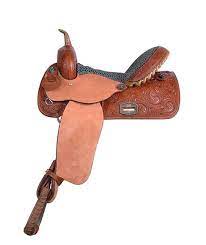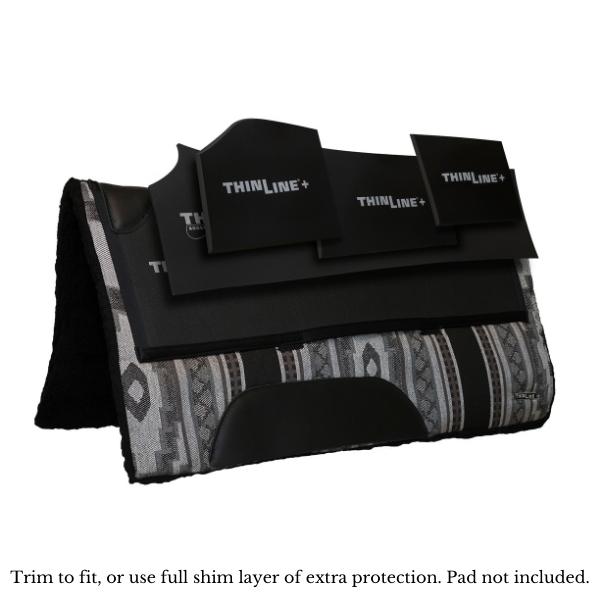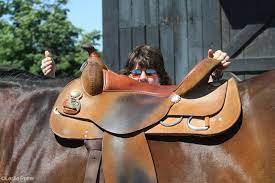With so many factors to consider, choosing the right Western saddle can often be overwhelming. This article provides a guide to selecting and fitting a Western saddle, including how to measure your horse and how to use saddle pad shims, a valuable tool for adjusting saddle fit.
Key Takeaways:
-
Proper saddle fit is crucial for both the rider and the horse.
-
Measuring your horse and trying on different saddles, cinches, and saddle pads can help you achieve the best fit.
-
Saddle pad shims are an excellent solution for many saddle fit problems.
-
Take the time to ensure a comfortable and secure fit to enjoy many happy rides with your equine partner.
Why Is It Important to Make Sure Your Saddle Fits Properly?
An ill-fitting Western saddle is dangerous for both horse and rider. It can cause discomfort, pain, and even long-term injury to you and your horse.
Tight, loose, or imbalanced saddles can cause pressure points and friction, leading to soreness, alignment problems, spinal injuries, and potential wounds on your horse’s back. If it’s too far forward, it may also limit the motion of the horse’s shoulder blade, causing traveling issues.
Therefore, it is crucial to evaluate your horse’s saddle fit regularly. Investing in a well-fitting saddle can significantly impact your riding experience and your horse’s comfort and health.
Signs of a Badly Fitting Saddle
Here are a few signs that may indicate a poorly fitting Western saddle:
-
Uneven sweat patterns: Uneven sweat patches, such as dry spots or areas where the hair has rubbed off, may indicate pressure points caused by an ill-fit.
-
Soreness or tenderness: Flinching, bucking, or reluctance to move forward may be due to an ill-fitting saddle causing pain or discomfort.
-
Inconsistent performance: If performance varies or declines, an ill-fitting saddle may be affecting balance, movement, or comfort.
-
Changes in behavior: Changes in behavior, such as biting or kicking, may be due to discomfort or pain caused by the saddle.
-
Saddle fit changes after a ride: Check for signs that the saddle is moving, such as sliding forward on the horse’s withers or backward toward the rump.
If a Western saddle fits poorly and the pommel or cantle presses into the horse’s withers or spine, it can limit movement, especially in the shoulder blade, or cause significant discomfort and injury to the horse.
When a Western saddle fits poorly, it poses dangers to both you and the horse. Saddle fit issues should be addressed promptly to avoid potential injury.
How to Measure a Horse for a Western Saddle
Correctly measuring a horse for a Western saddle is vital to ensuring a great fit and optimal comfort.
You can follow the steps below when measuring your horse for a Western saddle:
-
Stand your horse on a level surface with its head facing forward.
-
Use a flexible measuring tape to measure the horse’s back length from the base of the withers to the point of the croup (where the tail meets the body). This measurement will give you an idea of the saddle size you need.
-
Measure the horse’s girth area by wrapping the measuring tape around the horse’s barrel, about 4 inches behind the horse’s elbow. Make sure the tape is snug but not too tight.
-
Place a flexible wire over the top of the horse’s back (about 1-2 inches back from the shoulder blade) and shape it gently to the horse. Then use your tape to measure the distance between each side of the wire. This measurement can help determine the height of the saddle’s gullet.
-
Assess the horse’s back shape and note any unusual contours or dips that may affect saddle fit.
-
Once you have a saddle, place it on the horse’s bare back (no pad). Check the levelness, looking for balance, and the gullet fit, confirming it’s 2-3 fingers from the horse’s withers.
-
Slip your hand beneath the saddle and check for consistent pressure. There should be even contact between the saddle and horse, with no large spaces of no connection.
Keep in mind that different saddle makers may have slightly different sizing charts, so it’s always best to refer to the manufacturer’s specific size guide before making a purchase.
Western Saddle Seat Size Options
Choosing the correct size Western saddle is another crucial piece of the puzzle. Western saddle seat sizes typically range from 13 inches to 18 inches, with most adult riders falling between 15 and 17 inches.
The seat size refers to the distance between the front of the saddle’s swell (the front part of the seat) and the back of the saddle’s cantle (the raised portion at the back of the seat). A saddle with a too-small seat can cause discomfort, pain, and balance issues, while a saddle with a too-large seat can cause the rider to slide around and have difficulty maintaining proper position.
To determine the right seat size for you, sit in the saddle with your feet in the stirrups and your knees bent at a 90-degree angle. You should be able to fit about one hand’s width between the pommel and yourself and the cantle and yourself. You should rest comfortably on the seat, with no pressure or pinching.
Different Types of Western Saddles
Here are a few examples of different types of Western saddles:
-
Barrel Racing Saddle: This type of Western saddle is lightweight and has a high cantle and deep seat to give the rider better balance and support when making sharp turns. See our western pads suitable for barrel racing.
-
Ranch Saddle: A ranch saddle is for ranch work, such as herding cattle or trail riding. It has a sturdy tree, a deep seat, and a large horn.
-
Roping Saddle: Designed for roping cattle, this Western saddle has a reinforced horn, a deep seat, and a sturdy saddle tree for roping and pulling cattle.
-
Trail Riding Saddle: This Western saddle is made for long rides. It’s lightweight with a flexible tree and has a padded seat and stirrups to absorb shock and reduce fatigue.
-
Show Saddle: Designed for horse shows, the show saddle is ornate and decorated with silver and other embellishments. It has a deep seat, high cantle, and low horn.
-
Cutting Saddle: A cutting saddle is lightweight and has a low horn and a flat seat for quick cuts.
Each saddle has unique features for specific activities, disciplines, or preferences.
Choosing the Right Saddle Pad
Good saddle pads provide cushioning, absorb shock, and prevent rubbing and friction between the saddle and your horse’s back.
Here are some factors to consider when choosing a pad for a properly fitting saddle:
Thickness
The thickness of the pad determines its cushioning and impact absorption. While it’s a challenging balance to strike, horse owners should choose a pad that provides enough cushioning for comfort without compromising the fit.
Shape
Saddle pads come in different shapes and sizes to fit a range of saddle types and horse anatomies. Choose a pad that fits your saddle correctly, covering the entire surface and preventing slipping or rubbing.
A well-fitted pad should also allow room for the horse’s withers and spine and avoid pressure points or wrinkles.
Purpose
Your riding discipline may affect your choice. Different pads are developed for specific activities like barrel racing or trail riding. A well-chosen pad can prevent injuries and extend the life of your saddle.
Using Saddle Pad Shims
Saddle pad shims help improve saddle fit and provide extra cushioning and reinforcement where needed. A shim is a thin, wedge-shaped piece of material that can be inserted between the pad and the horse’s back to adjust the fit and balance of the saddle.
Here’s what you need to know about using shims:
Identify the Problem Areas
Before using shims, identify the problem areas in your saddle fit. Look for uneven pressure points, gaps, or rubbing between the saddle and the horse’s back. Pay attention to the saddle’s balance, levelness, and clearance over the withers and spine.
Choose the Right Type of Shim
Shims come in various materials, such as foam, felt, or gel. Choose a shim that matches the material and thickness of your saddle pad and delivers the desired level of support and cushioning.
Some shims come in sets with different thicknesses and shapes for more precise adjustments. At ThinLine, our Adjustable Saddle Pad Shims are made with a thin, shock-absorbing, non-slip breathable foam that never compresses, so the shims can last a lifetime.
Place the Shims Correctly
Shims should be placed strategically to correct the saddle fit and balance. They can be put in different areas, such as under the front or back of the saddle, over the withers or spine, or on the sides of the pad.
Always follow the manufacturer’s instructions and use shims sparingly, as over-padding can cause more harm than good.
Check the Fit
After inserting the shims, check the saddle fit again to ensure pressure points are alleviated, the saddle is level and balanced, and there is no rubbing or slipping. Finding the right combination of shims and placement may take some trial and error, so be patient and observant.
Regularly Inspect and Adjust
Saddle fit can change over time due to changes in your horse’s weight, shape, or fitness level or due to wear and tear of the saddle or pad. Regularly inspect and adjust the saddle fit and shims to ensure your horse is comfortable and performing at its best.
Overall, shims can be useful for achieving superior saddle fit and comfort. Riders should use them in conjunction with proper saddle fitting techniques and regular inspections.
Common Mistakes Horse Owners Make Regarding Saddle Fit
Saddle fitting is a complex aspect of horse care that requires attention to detail and knowledge of equine anatomy, biomechanics, and saddle design.
Here are a few common mistakes that horse owners make regarding saddle fitting:
-
Assuming one size fits all: Saddles come in different sizes, shapes, and styles. It’s a mistake to assume that one saddle size or model will fit all horses or riders.
-
Neglecting the horse’s conformation: Each horse has a unique conformation, with variations in the shape, width, and angle of the withers, shoulders, back, and ribcage. Consider your horse’s conformation when choosing a saddle to ensure the saddle doesn’t put pressure on or restrict movement in any of these areas.
-
Focusing only on the saddle: Saddle fit is about the saddle itself and the saddle pad, cinch, and rider position. Neglecting any of these factors can affect the saddle fit and cause discomfort or rubbing to your horse.
FAQs About Fitting a Western Saddle
Horse owners typically have many questions about fitting a Western saddle. We answer a few Western saddle fitting and caretaking questions below.
How Do I Maintain a Western Saddle?
Properly maintaining your Western saddle is vital to prolonging its lifespan and ensuring safety and comfort. Follow the care directions followed by the saddle manufacturer closely.
Generally, however, clean mud, sweat, and debris from the saddle after each use. Avoid exposing the saddle to direct sunlight or extreme temperatures, and regularly oil and condition leather to keep it supple and prevent cracking or drying out.
Also, periodically check the cinch and stirrup leathers for signs of wear and tear.
Is the Type or Style of the Cinch Important?
Yes, the type or style of the cinch is essential when fitting a saddle. The cinch goes around the horse’s girth area and secures the saddle to the horse’s back. The wrong cinch can cause discomfort, rubbing, or even injury to the horse, affect its movement and performance, and compromise the saddle fit.
Some factors to consider when choosing the best Western cinch include the material, length, width, shape, thickness, flexibility, breathability, buckle or fastening system, and ease of maintenance. The cinch should fit snugly but not too tightly and not rub or pinch or interfere with breathing or movement.
What Are Good Questions to Ask When Choosing a Western Saddle?
Here are a few simple questions to ask yourself when selecting a new saddle:
-
What is my horse’s breed, size, and conformation?
-
What is my riding discipline and level of experience?
-
What is my budget for a new saddle?
-
What type of saddle tree and seat size do I need?
-
Can I try the saddle on my horse before buying it?
-
Do I need professional advice or fitting assistance?
Finding the Perfect Western Saddle for Your Horse
If you’re having trouble achieving the perfect saddle fit, saddle shims can be a helpful tool for adjusting the fit of the horse saddle. That said, it’s crucial to use saddle shims properly and seek the advice of an experienced horseperson when making adjustments.
A saddle that fits the rider and horse properly makes the riding experience safer and more fun, so it’s worth the time and expense to fit a Western saddle correctly.




